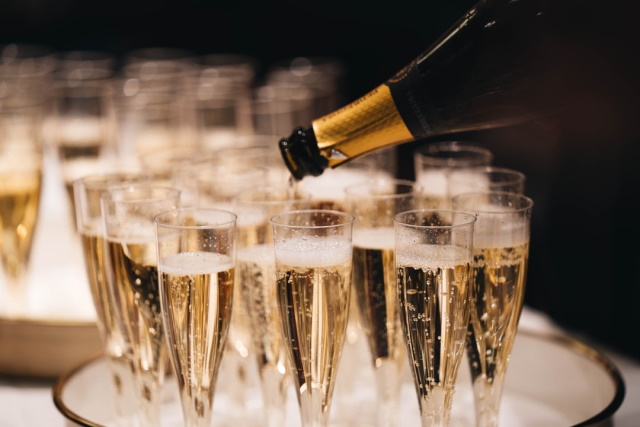
Used for toasting everything from life's greatest accomplishments to its simplest pleasures, Champagne has become synonymous with celebration.
Champagne is a French sparkling wine that is often used to refer to other bubblies from other places, but don't be fooled — not all sparkling wine has the honor of being a true Champagne. This classic wine can only earn the moniker of if it is from the Champagne wine region of France. Master winemakers create the renowned bubbly under strict guidelines, through carefully honed grape-pressing methods and time-consuming secondary fermentation.
If you're an avid bubbly connoisseur, you know that tried and true Champagne offers a distinct taste and experience that other sparkling wines can't match. No matter your palate preferences, there is a wide variety available to suit your unique tastes.
Read onward to find out how the distinct, classic bubbles in Champagne are created!
A Short History of Champagne
Despite the well-known legend that Dom Perignon invented sparkling wine, it was, in fact, created accidentally in France during the 17th century — though Perignon did undoubtedly contribute to the quality and processes behind its modern iteration.
In the early days, bubbles in wine were considered a flaw and earned early versions the name le vin du diable, or "the devil's wine," for its unpredictable behavior.
Once sparkling wine came to be appreciated for its unique taste and texture, Champagne was produced by the méthode rurale, in which wine was bottled during initial fermentation. Champagne was not made via the méthode champenoise, which is now considered the traditional process, until the 19th century, after which time Champagne became widely produced and earned ubiquitous popularity.
If you enjoy the luxe, upper-crust quality conjured by a quality glass of Champagne, you're not alone. Champagne was associated with royalty well into the 19th century. Modern Champagne is notably drier than the drink royalty of yesteryear enjoyed, with the designation of Brut emerging late in the 1800s.
The Science of Bubbles
The fizzy quality of Champagne, known as its effervescence, is paramount to the experience of enjoying it. These delightful bubbles are produced when yeasts within the liquid ferment sugars to create carbon dioxide gas. Carbon dioxide gas creates the beloved bubbles in all sparkling wine, including Champagne. In turn, these CO2 bubbles generate pressure within the bottle that results in the classic "pop" associated with opening a celebratory bottle.
The amount of carbon dioxide bubbles that bubble, or "nucleate," within a glass of Champagne is determined by a complex set of factors, including the amount of dissolved CO2, the number of minuscule gas pockets trapped within particles, and "ascending bubble dynamics" such as microscopic fibers within your glass.
These factors were recently explored in a study published by The Journal of Physical Chemistry. Through scientific study fueled by whimsical inquiry, researchers at the University of Reims, France, discovered that the "trains," or streams of bubbles, were diverted by tiny gas pockets left behind by dust particles. The study also notes that the sparkle of your Champagne significantly affects its texture, aroma, and even taste. These factors can be further attuned through temperature and tilt of the flute.
Researchers estimate that each glass of Champagne possesses the potential to create one million bubbles — if you leave it untouched. The study recommends that you serve Champagne warmer than usual if you are looking for a fizzier experience. To enhance the bubbling effect even further, wipe your glass with a towel before serving. If you prefer a calmer flute, you should plan on air-drying your glasses upside down to reduce bubbling.
Modern Bubbles: How Champagne Is Made
The bubbles you see in your glass are the result of a long and arduous production process. So, where do these bubbles come from in the first place?
While there are many processes for creating Champagne and sparkling wine, many aficionados swear that the méthode champenoise is the premier procedure for creating optimal bubbles.
The entire Champagne-making process occurs over two weeks, during which time the following steps are taken:
- Tirage: Grapes are harvested and pressed in a la cuvée process. The juice becomes alcohol during the first round of fermentation. Then, a skilled winemaker adds liqueur de tirage — a special concoction of sugar and yeast cells — to the still wine to create the base.
- Bottling: Base wine is decanted and poured into bottles. The bottle is sealed with a crown cap similar to a bottled beer and racked, horizontally, on wooden racks known as pupitres.
- Remuage: Reumuage, or riddling, involves turning the bottled a quarter turn every day. The quarter-turn disturbs the sediment and lees within the bottle.
- Disgorgement: Dégorgement is the phase in which the winemaker flips the bottle upside down. The lees will settle in the neck of the bottle. Most winemakers will remove the lees via freezing — leaving behind only unsullied bubbles within the Champagne.
- Dosage: If needed, the winemaker will utilize a liqueur d'expédition, or dosage, during which dryness or sweetness is adjusted.
Enjoying Your Champagne
The next time you're enjoying a quality glass from JJ Buckley's Champagne selection, remember that the effervescence was achieved through a delightful combination of science and careful tradition. Check out some of our bestsellers and bring the magic of a quality glass of bubbly straight to your home.
Are you looking for a recommendation for your next bottle of Champagne? If you're looking to build your current collection through personal recommendations, consider the quality services that our Fine Wine Specialists provide. We pride ourselves on providing advice that is accessible, honest, and knowledgeable. Contact us to learn more about our unparalleled service.